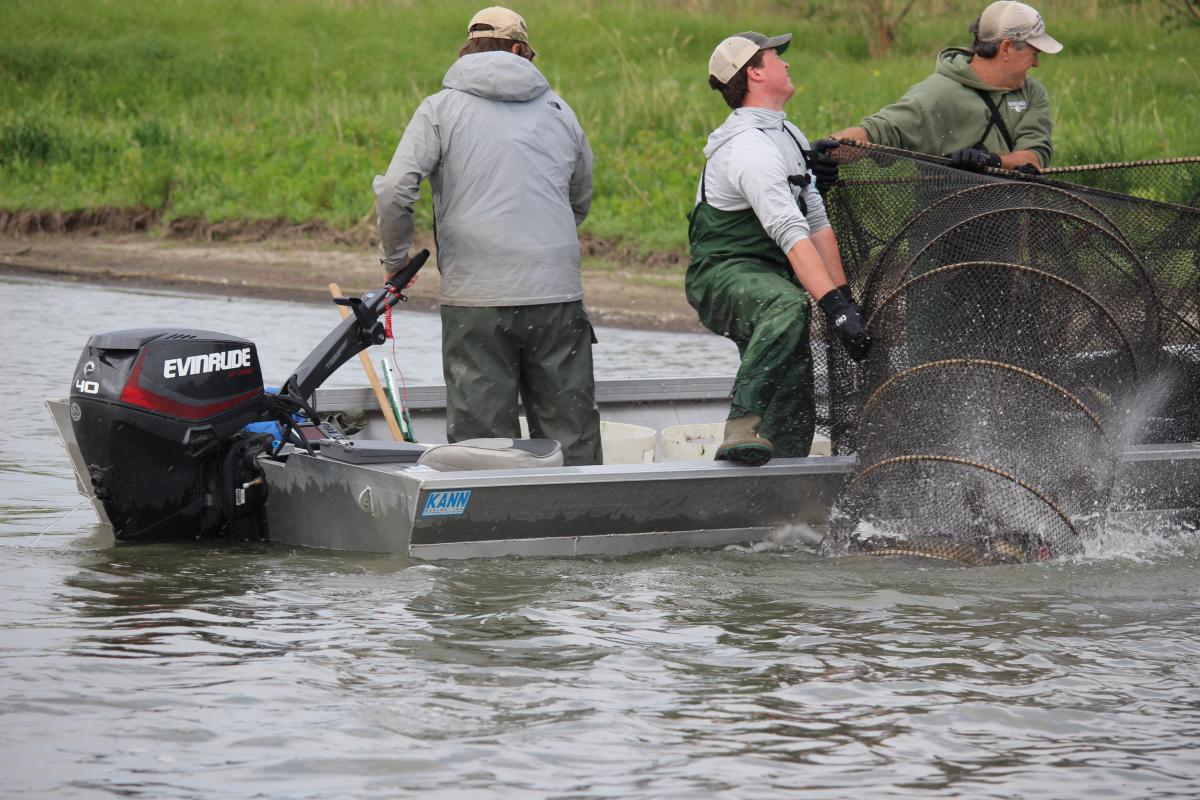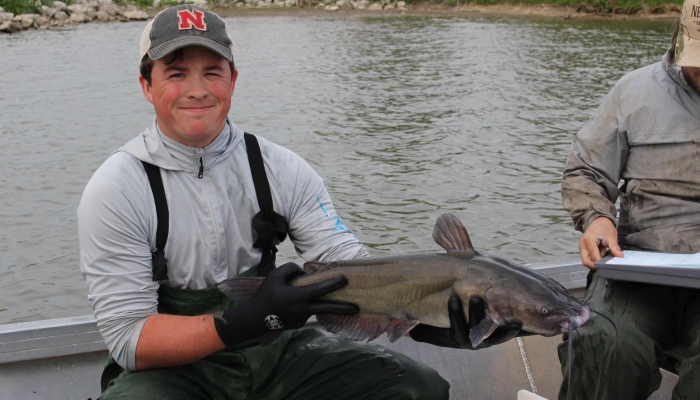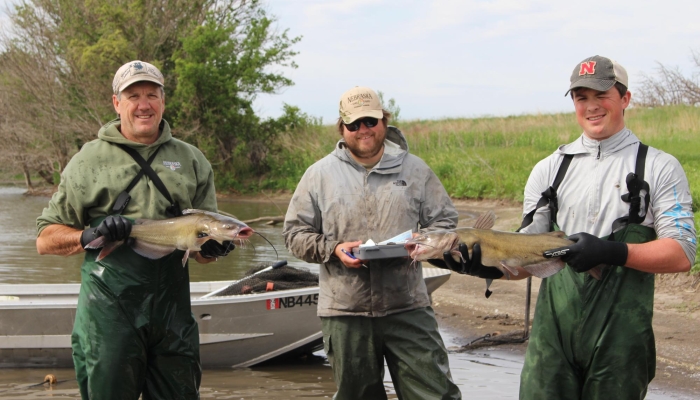Gone Fishin’
Local lake assessed for fishery health
It is overcast and cool on the lake at Pioneer Trails Recreation Area on the morning of June 1, as a team from Nebraska Game and Parks Commission (NGPC) readies their equipment: boats, buckets, long handled nets, and measuring boards. “I’m not sure what we’re going to find in there,” says Brad Eifert, NGPC southwest district fisheries manager, noting the lake’s cloudy water. Eifert and his colleagues, fisheries biologists Alex Engle and Drayden Bellamy, are dressed in green chest waders and neoprene gloves. The trio motors across the lake to the first of four fish traps they had set out the day before to begin a survey of the fishery. The last time such a survey was done was in 2017. Public access lakes across Nebraska that are regularly stocked with fish by NGPC are surveyed rotationally to ensure that the conditions in the lake continue to be adequate to maintain fish populations.
As two of the team members work together to haul the nets up out of the water, it is clear there are indeed plenty of fish in the 40-surface-acre lake near Aurora. The flopping mass of fish inside the trap net are deposited into large buckets on the boat, then examined one by one. Each wet and wriggling body is placed on a measuring board, then sizes and species are recorded on a clipboard. The biologists note the number of each species present and the condition of the fish, before releasing them back into the lake.
This net contains mostly channel catfish, the official fish of Nebraska, but also some white crappie. “Catfish are well suited to water of this turbidity, so we stock them every other year here,” says Eifert, tossing an olive-brown, whisker-faced fish back into the lake.
Turbidity is a measure of the degree to which water loses its transparency due to the presence of suspended particulates. Erosion from nearby agricultural fields is a likely cause of the turbidity at the lake at Pioneer Trails, and many lakes in Nebraska. The more total suspended solids in the water, the murkier it is and the higher the turbidity measurement. This is a fine environment for catfish, as they hunt by smell and not by sight, however it can be a challenge for other species of fish, including largemouth bass, which rely on vision to catch their prey. The increased turbidity also means less plant growth in the lake, which leads to a loss of food and habitat for some fish species.

Still, there appears to be a decent number of fish in the lake at Pioneer Trails today, even with a higher level of turbidity. The second net trap Eifert and the team reach for is so full that they can’t pull it into the boat. Filled with hundreds of struggling fish, the net is dragged closer to the shoreline where the team gets out of the boat to catalog its contents. This one, too, is filled with mostly catfish, some reaching 27 inches in length (probably about eight pounds). According to US Fish and Wildlife, the average size for a channel catfish is 22 inches, but some can reach the gargantuan proportions of 52 inches and 40 to 50 pounds.
There are two additional net traps to check, but the team switches tactics to check on other species. While catfish congregate in the dark depths of the lake and are easily caught in the nets, other species tend to remain closer to the surface and require a different strategy to survey. The NGPC team lowers two booms with dangling metal octopus-like probes into the water. These devices send an electric current through the water near the boat that stuns the fish in a small radius. The immobilized fish float to the surface, unharmed though unable to escape. The team trawls the south end of the lake for 10 minutes, collecting what comes to the surface with long handled nets and depositing the fish into a holding tank on the boat.

Measuring this lot is faster, as the stunned fish put up less fight than the confined catfish. The shallow water survey reveals dozens of bluegills in various shades and sizes. “There must be a good spawning spot over here,” Eifert notes, pointing out the striking orange bellies of the breeding males and the large number of immature fish collected nearby. Bluegills can reach up to 12 inches in length, but most collected at Pioneer Trails today are smaller (six to eight inches).
Several keeper-size (15 inches or larger) largemouth bass also turn up during this collection, as well as an abundance of 5-8 inch bass. This species is highly sought prized by Nebraska anglers, but a challenge for many Nebraska lakes due to the turbidity factor. The survey also revealed several saugeye, a sauger-walleye cross that was created in NGPC hatcheries and released in lakes across the state. The long, spiny species cannot reproduce naturally, so regular restocking is necessary to maintain the population. The benefit of this hybrid species is that it does well in turbid waters.
“The fact that we didn’t shock any carp is a good sign,” says Eifert. Common carp area an invasive species in Nebraska that can be very destructive to fisheries as their feeding patterns stir up the bottom of the lake in shallow areas and increases turbidity. This process kills many plants that other fish and waterfowl rely on for food and habitat. Carp can grow large quickly and are good to eat, which is why the species native to Asia was introduced into Nebraska’s waterbodies by anglers more than a hundred years ago. However, anglers are asked to never stock fish in Nebraska’s lakes without the consent and cooperation of NGPC to avoid additional damage to aquatic ecosystems.
The biologists from Nebraska Game and Parks Commission will draft a summary report of the findings of the fish survey this winter, as well as make recommendations for fishery management for the lake at Pioneer Trails Recreation Area. The previous report, published in January 2018, is available here.

About Pioneer Trails Recreation Area
Just a mile from highway 34 near Aurora sits a tranquil lake with lots to offer. Pioneer Trails Recreation Areas features amenities such as picnic shelters, grills, restrooms, and camp sites for RVs and tents. The amphitheater overlooking the lake is a great place for a gathering or performance. Trails around the lake are perfect for biking and hiking. Fishing and boating are popular activities at this park. Constructed on a tributary of Lincoln Creek in 1986, the reservoir was designed to provide flood control, aquifer recharge, wildlife habitat, and recreational opportunities.Fish consumption advisory: Many waterbodies in Nebraska have an increased load of certain toxins that may cause health concerns for those that consume a large amount of fish from these lakes and rivers. As of the most recent report (2020) from the Nebraska Department of Environment and Energy, the lake at Pioneer Trails recreation area is listed as having increased levels of mercury. The advisory is not a ban on eating fish from affected waterbodies, but it is suggested that the public limit long-term consumption of fish caught from those specific waterbodies to eight ounces per week (for adults).
For more information on NGPC’s involvement in maintaining fisheries in Nebraska, visit http://outdoornebraska.gov/fisheriesprograms/.
For more information on recreation areas managed by the Upper Big Blue NRD, visit www.upperbigblue.org/recreation.

NRD Projects Department Manager Jack Wergin shows off a largemouth bass collected during the fish survey at Pioneer Trails Recreation Area.


